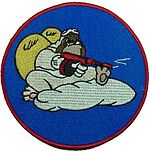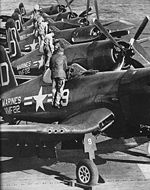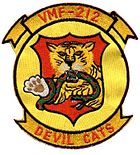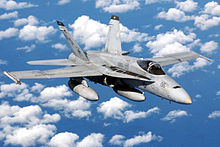- VMFA-212
-
Marine Fighter Attack Squadron 212 
VMFA-212 Unit insignia
Courtesy of www.military-graphics.comActive March 1, 1942–March 11, 2008 Country United States Branch USMC Part of Inactive Nickname "Lancers"
Hell Hounds (WWII)
The Musketeers (WWII)
Devil Cats (Korea)Motto "Train to Fight, Fight to Win!" Tail Code WD Engagements World War II
* Battle of Guadalcanal
* Philippines campaign (1944–45)
* Battle of Okinawa
Korean War
* Battle of Chosin Reservoir
* Attack on the Sui-ho Dam
Vietnam War
Operation Desert Storm
Operation Desert Storm
Operation Southern Watch
Operation Noble Eagle
Operation Enduring FreedomCommanders Notable
commandersLtCol Harold "Indian Joe" Bauer Aircraft flown Attack AD-1 Skyraider Fighter F4F Wildcat
F4U-4 Corsair
F-4 Phantom II
F/A-18 HornetMarine Fighter Attack Squadron 212 (VMFA-212) is a United States Marine Corps F/A-18 Hornet squadron, which is currently in a cadre status. Most recently known as the "Lancers", the squadron was last based at Marine Corps Air Station Iwakuni, Japan and fell under the command of Marine Aircraft Group 12 (MAG-12) and the 1st Marine Aircraft Wing (1st MAW). Due to a re-organization within Marine aviation, the squadron was placed in a cadre status in 2008, awaiting revival as an F-35 squadron.[1]
Contents
Mission
Support the Marine Air-Ground Task Force commander by destroying surface targets and enemy aircraft, day or night under all weather conditions during expeditionary, joint or combined operations.
- Conduct sea and air deployment operations.
- Conduct fire support.
- Conduct close air support.
- Conduct interdiction operations.
- Conduct joint suppression of enemy air defenses.
- Conduct air to air operations.
- Coordinate battle space maneuver and integrate with firepower.
History
World War II
Marine Fighter Attack Squadron 212 was activated as Marine Fighting Squadron 212 (VMF-212), the "Hell Hounds", at Marine Corps Air Station Ewa, Hawaii on March 1, 1942. Deploying in May to the South Pacific in their F4F Wildcats, the squadron was stationed at Tontouta on the island of New Caledonia, and later moved up to the island of Efate. As preparations for the invasion of Guadalcanal increased, the squadron operated a detachment at Espiritu Santo until the arrival of VMO-251 ensured that the island was provided with adequate aerial defense. During the early part of the Guadalcanal campaign, VMF-212 sent detachments to operate with Cactus Air Force squadrons deployed to Henderson Field until the entire squadron was committed to the battle in mid-October. The squadron acquired an enviable record by destroying 64½ enemy planes including that of Toshio Ohta, a Japanese ace. Of this number, LtCol Harold "Indian Joe" Bauer, the squadron's first Commanding Officer, was credited with 11 kills and posthumously awarded the Medal of Honor for his valor.
The squadron returned to the United States in November 1942 and remained on the West Coast until June 1943 when they sailed for Midway Atoll. The squadron remained on Midway for two months and then returned to Espiritu Santo. By August 1943, VMF-212 was back in the Solomon Islands where they participated in the campaigns to retake Vella Lavella and Bougainville. From October 20 through November 27, 1943 the squadron was based out of Barakoma and supported operations in the Treasury Islands, Choiseul and Bougainville. By December 1943 they moved to Torokina and remained there until they moved again on January 20, 1944 this time to Piva. Another move came on March 20 when they transited to Green Island and later back to Vella Lavella. 212 remained in the vicinity of the Solomons and Bismarck Islands for the remainder of 1944 running fighter sweeps against the Japanese garrison on Rabaul and providing close air support for ground forces on Bougainville. On January 8, 1945, VMF-212 landed on Samar and provided close air support for United States Army troops during the campaign to retake the Philippines. During this time they flew over Mindoro, Luzon, Visayas and Mindanao. It was also during this time that the squadron was a part of one of the worst aviation accidents of the war. At 0940 AM on January 24, 1945, while taking off, 1stLt Karl Oerth of VMF-222 hit a lump in the runway, blew a tire and his Corsair careened wildly into his own squadron's revetment area, which was shared with VMF-212. It completely wiped out the tents housing the intelligence, oxygen, parachutes and materiel departments. Many men attempted to rescue the pilot but while they were making this brave effort the plane exploded and set off all its .50 cal ammunition. 14 men were killed and over 50 wounded during this incident.[2] In June 1945 the squadron arrived at Okinawa on the USS Hillsborough County (LST-827) and conducted operations from there until the end of the war.[3] During the duration of World War II, VMF-212 was credited with shooting down 132½ enemy aircraft[4]
Korean War
VMF-212, with no nickname at the time, was one of the first squadrons sent to Far East at the outbreak of the war. They remained in Japan until Marines were able to capture Kimpo Airfield after the Battle of Inchon. The squadron finally touched down in Korea on September 18, 1950 and were flying their first strikes by the 20th of September. The squadron was later moved to Yonpo Airfield in North Korea as the United Nations' forces continued their advance in the early winter of 1950. The squadron adopted the name "Devil Cats" and a new patch was designed. After the Chinese counterattack in late November 1950, VMF-212 aircraft flew almost continuous close air support missions supporting the 1st Marine Division as they fought their way out of encirclement during the Battle of Chosin Reservoir. After the fighting at Chosin, the squadron was ordered to operate from the USS Bataan (CVL-29), where they remained until March 5, 1951.
VMA-212 moved to being land based, first just south of Wonson Harbor, where it was too close to enemy fire for landings and take-offs. It then moved to K-6 at Pyongteak as a part of MAG-12, which also included VMA-323 flying F4U Corsairs and VMA-121 flying AD Skyraiders. VMA-212's F4U Corsairs were replaced by upgraded AU-1 Corsairs in 1952. The AU-1 Corsair had armor plate around the cockpit and the oil coolers that were moved up to behind the engine. The squadron dropped more ordinance during the Korean War than any other Marine Corps squadron[citation needed]. The AU-1 Corsair had an additional center bomb rack which carried a 2000 lb. bomb until the rough Marston Matting, which was laid over the old pock-marked Japanese landing strip at K-6, caused the center bomb rack to break off. The AU-1 Corsair could carry a 2000 lb bomb on its center rack, two 1000 lb. bombs on the wing root bomb racks and 100 or 260 lb. bombs on its wing racks. It struggled up to enemy territory at approximately 140 knots. After releasing its bombs, the AU-l again became a fast fighter in close support of the front lines and a fighter capable of up to 600 knots in a dive. Colonel Robert Galer, a Marine Corps Ace from World War II, was the Commanding Officer of MAG-12 in 1952, when he was shot down behind enemy lines and protected by VMA-212 pilots until rescued by a Marine Corps helicopter. VMA-212 remained in Korea until the end of the war in July 1953. From April 1951 to May 1953, VMA-212 lost ten pilots.
The Vietnam War & the 1980s
In April 1965, the squadron, now known as the "Lancers" sailed aboard the USS Oriskany becoming the first Marine jet squadron to be deployed aboard an aircraft carrier in combat. As part of Carrier Air Group 16 (CVW-16) they arrived off the coast of Vietnam and began operating from Yankee Station. From May 10 to December 6, 1965 the Lancers flew missions against targets in North and South Vietnam. During this tour they conducted more than 12,000 combat sorties and delivered nearly 10,000 tons of ordinance. Of note, during a mission on September 9, 1965 they became the first squadron to deliver 2,000 lb MK-84 bombs from an F-8 Crusader that had launched from an aircraft carrier. Also on that day the Commander, Air Group (CAG) of CVW-16 Commander James Stockdale's A-4E Skyhawk was shot down over North Vietnam[5] making the commanding officer of VMF(AW)-212 the acting CAG until a replacement arrived.[6] This made 212's Commanding Officer LtCol Chuck Ludden the first Marine Officer to command a carrier airwing. In December 1965 the squadron returned to Hawaii having flown 3,018 combat hours and 1,588 sorties during their time off the coast of Vietnam.[7] In April 1972, the squadron deployed from Hawaii to Da Nang, South Vietnam in an effort to blunt the massive North Vietnamese invasion of South Vietnam. VMFA-212 earned a Meritorious Unit Commendation for its effort in Vietnam.
From 1974 until 1987, VMFA-212 deployed numerous times to Japan and the West Coast earning the CNO Aviation Safety Award, the Robert M. Hanson Award, and the Meritorious Unit Commendation. During October 1988, VMFA-212 completed its seventh and final rotation in the UDP as an F-4 Phantom squadron. With the last F-4 sorties flown in August 1988, over 23,000 accident-free hours had been accumulated. The F/A-18C Hornet was received at this time.
The Gulf War & the 1990s
In December 1990, the squadron deployed to Bahrain in support of Operation Desert Shield. From there, they flew air interdiction and close air support missions in support of coalition forces during Operation Desert Storm after January 17, 1991. On August 13, 1996 the Lancers took off for the final time from NAS Miramar enroute to MCAS Iwakuni, Japan. After a successful six month cycle the Lancers became a permanent resident of MCAS Iwakuni.
The Global War on Terror
The Lancers were the first Marine Corps squadron to deploy after the September 11 attacks. The squadron left MCAS Iwakuni on September 14 and began flying Combat Air Patrols over Guam in support of Operation Noble Eagle.
In the spring of 2002 the squadron deployed to Kuwait. For the first time single seat C models and 2-seat Ds from VMFA (AW)-332 The Moonlighters were combined into one unit. The Moon-Lancers flew missions into Iraq in support of Operation Southern Watch and Afghanistan in support of Operation Enduring Freedom. The OEF missions were, on average, 10 hours in duration and mostly at night.
Due to a re-organization within Marine aviation, the squadron was placed in a cadre status in 2008 in order to facilitate the Corps's transition to the F-35.
Squadron aces
The following members of VMF-212 were credited with shooting down at least five Japanese aircraft and earned the right to be called an Ace. The numbers after their name represents the number of enemy aircraft they were credited with shooting down.
- Harold W. Bauer - 11.0
- William A. Carlton - 5.0
- Jack E. Conger - 10.0
- Phillip Cunliffe DeLong - 11.2
- Frank C. Drury - 6.0
- Hugh Elwood - 5.2
- Loren D. Everton - 12.0
- Henry B. Hamilton - 7.0
- John McManus - 6.0
- Donald C. Owen - 5.0
- Frederick R. Payne - 7.5
- Francis E. Pierce Jr. - 6.0
- George H. Poske - 5.0
- Robert F. Stout - 6.0.[8]
MIA information
In May 2008, a team from the Joint POW/MIA Accounting Command found the wreckage of an F4U Corsair (BuNo 55908) and the remains of 1stLt Allan S. Harrison III in the vicinity of Warangoi, Papua New Guinea.[1] 1stLt Harrison was shot down by a Japanese aircraft on February 11, 1944 while taking part in a raid on the Japanese garrison at Rabaul.[1]
See also
- United States Marine Corps Aviation
- List of active United States Marine Corps aircraft squadrons
- List of inactive United States Marine Corps aircraft squadrons
References
- Notes
 This article incorporates public domain material from websites or documents of the United States Marine Corps.
This article incorporates public domain material from websites or documents of the United States Marine Corps.
- ^ a b c LtGen John Castellaw (2007) (PDF). 2007 Marine Aviation Plan. Headquarters Marine Corps. Archived from the original on 2007-11-27. http://web.archive.org/web/20071127050437/http://hqinet001.hqmc.usmc.mil/AVN/Documents/Signed+AvPlan.pdf. Retrieved 2007-11-18.
- ^ "JOHN GALLE'S 212 HISTORY PAGE". Archived from the original on 2009-10-25. http://www.webcitation.org/query?url=http://www.geocities.com/capecanaveral/lab/5428/galle212.html&date=2009-10-25+06:39:10. Retrieved December 16, 2007.
- ^ Sherrod History, p. 460-461.
- ^ Sherrod History, p. 430.
- ^ "POW S". Project Get Out and Walk. http://www.ejection-history.org.uk/project/POW/pow_s.htm. Retrieved 2008-06-25.
- ^ White-Hoffman, Nancy Lee (May 2008). "VMF(AW)-212 - First Crusader Squadron to Deliver 2,000 Pound Bombs in Combat". Leatherneck: pp. 52–53.
- ^ Ginter, p. 13
- ^ "List of WW2 Marine Aces". www.Acepilots.com. http://www.acepilots.com/usmc_aces_list.html.
- Bibliography
- Crowder, Michael J. (2000). United States Marine Corps Aviation Squadron Lineage, Insignia & History - Volume One - The Fighter Squadrons. Turner Publishing Company. ISBN 1-56311-926-9.
- Rottman, Gordon L. (2002). U.S. Marine Corps World War II Order of Battle - Ground and Air Units in the Pacific War, 1939–1945.. Greenwood Press. ISBN 0-313-31906-5.
- Ginter, Steve (1989). Naval Fighters Number Eighteen - Part Three - Vought's F-8 Crusader - Marine Fighter Squadrons. ISBN 0-942-61218-3.
- Sherrod, Robert (1952). History of Marine Corps Aviation in World War II. Washington, D.C.: Combat Forces Press.
- Web
Categories:- United States Marine Corps fixed wing squadrons
- Inactive units of the United States Marine Corps
- United States Marine Corps units and formations in the Korean War
Wikimedia Foundation. 2010.








